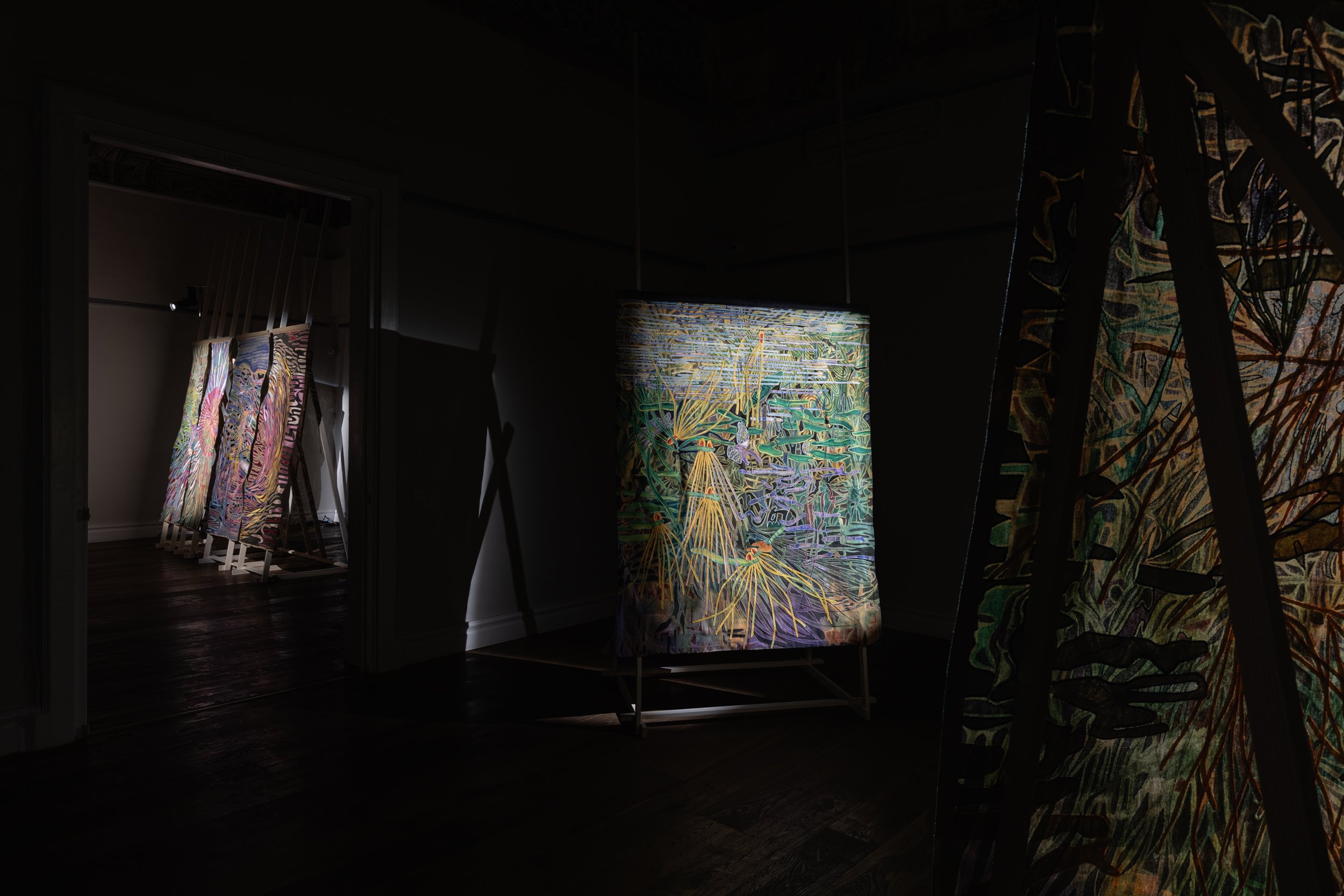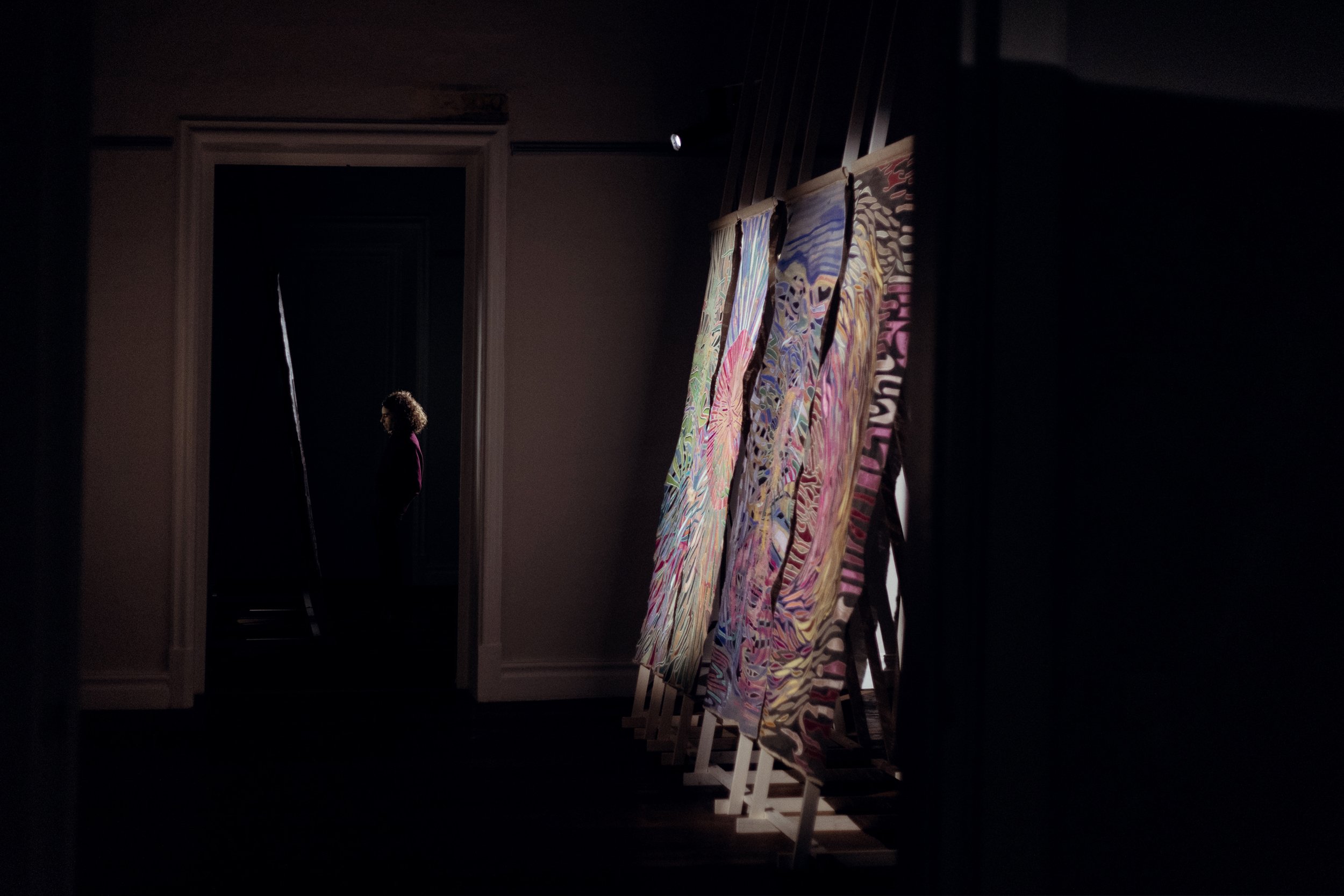A PACT: THROUGH THE EYE OF THE NEEDLE
“In practice, threading a needle is difficult and symbolically the eye of the needle serves as the narrow entrance into Heaven, excluding all but the worthy. Only our real Self can gain entrance when all of its disguises have been shed. The needle’s “eye” is described as the “Sundoor” or “Eye of the World” from which life emanates and returns.”
—Mark Siegeltuch, The Thread-Spirit Doctrine.
(Left, Ancient of Days, William Blake, 1794)
A PACT
Weaving is an act of pact-making. It brings two foreign bodies into an arrangement which reinvents what they are able to stand as alone. In the interlacing of these two grammars, a new language is formed. As in all languages, there is scope to interpret here beyond the superficial appearance of what a woven fabric is capable of doing or being. Sewing goes even further in securing the permanence of this pact. The needle binds and takes from each material, whilst introducing a foreign body to keep it held tight.
THROUGH THE EYE OF THE NEEDLE presents Stefan Spiteri’s latest reckoning with the depth which canvas has to be explored. This is not the result of arbitrary experimentation from within the artist’s studio. What Spiteri is proposing is a woven reconciliation not only with his personal context and story, but also the vernacular artworks used to dress streets in praise of saints in his home country Malta. The jute artwork which his mother Speranza created at the tender age of 18 holds considerable value for this body of work. The maternal artworks which he references as the starting point of this project, are in direct dialogue with the flatly decorated banners hung in streets for local village feasts; the ‘bandalori’. The dexterity of the needlework in the former is in stark contrast with the flatter mark-making methods of the latter. The common ground between both seems to have birthed something conceptually and technically substantial within this young artist’s practice.
Whilst meaning in painting can appear to be more explicit, one could argue that broad swathes of visual art fall short of exploiting the implied knowledge that is embedded within each warp and weft of its canvas. Spiteri’s inquisitiveness lies at this very intersection. How is it that we propose actual depth, rather than the illusion of it? How does a fabric extend beyond the surface that it creates? This is the imperative of the artist as his work transcends the boundaries of both.
As I look at his patchworks I am somehow repeatedly transported to the Ancient of Days by William Blake, an artist who created his own mythology to speculate on the critical time within which he thought and worked. Urizen is depicted as an aged man crouching downwards, leaning to the edges of the frame, creating a triangle out of an architect’s compass. He establishes a direct link between the mystical and the worldly; a character emerging from a raging sun, with an arm outstretched down to what we understand is the Earth.
Colour is for Stefan Spiteri an important departure from the physical world. The tapestries enter the metaphysical and mystical, in the way that their depth is amplified through the contrast of each woven piece. His chromatic decisions are technical and not just aesthetic. They create an opportunity to heighten the presence of the seam and weave not only what he is seeing, but also what he wishes to see. In this way it presents a process of healing, with each canvas doing more than just portraying, but rather ‘becoming’. This relationship with a woven fabric folds onto his own relationship with his mother. Its domesticity comes together almost as a pact of its own, exhibited within this show to transcend the time and space in which each of them first had an opportunity to create. Speranza translates to ‘hope’ in Maltese. Spiteri’s connection to his mother seems to be woven into his works in more ways than one.
The pact comes at the chance to mend, and to understand that as depth is created there is reconciliation and that the needle builds on what the brush first provides. The works suggest a complex landscape that has only been made more dense through the superimposition of his process. The artist makes a pact as he paints, weaves and then sews to bind the material as one. He not only exposes the way things come together but he also seals them at their edges. The substance of the work lies at the fringes, where the artist exposes his pact of joining at torn seams. This manifestation of art-making maps quite interestingly on the idea of fixing. That the needle doesn’t just produce but it mends. It fixes in a place of fragments and teaches a lesson of what this method could offer if transposed elsewhere. In this way the artist’s work replicates the mother’s. The needle offers a new lineage between the two, an artist and his non-artist mother. Revisiting the works almost fifty years later, she repositions her craft without losing the way she had already seen. She does this alongside her son, who borrows from and joins in his mother’s complex web.
The eye of the needle is for Stefan Spiteri a ‘difficult’ way of seeing, but a more honourable way of pursuing healing. A ‘narrow[er]’ way in, to a more honest outcome which ties with the hyperbolic use of the term in the sacred texts of the three monotheistic religions. The aesthetic experience of Stefan Spiteri’s method does not forego the ‘difficult[y]’ of threading a needle, but rather it uses it to extend on larger questions; around the limits of painting, the bedrock of his artistic practice; and the greater idiosyncrasies of our time.
THROUGH THE EYE OF THE NEEDLE also comes at an important juncture. As the fringe between East and West becomes a turbulent time once more, the needle gains momentum as a powerful tool. A pact-making metaphor implies a tapestry which is permanently adapted but also intrinsically bound.
If we can see through the eye of the needle the world could appear quite different. Stefan Spiteri doesn’t paint a picture of it, he takes the time to weave it into place and does this within a long lineage of threaded histories. The work is a spiritual reckoning within a world that often stops at edifice. Spiteri uses the needle to show there is more depth to a surface than what initially appears - that no element can avoid fraying and that a return to mending is the only way.




